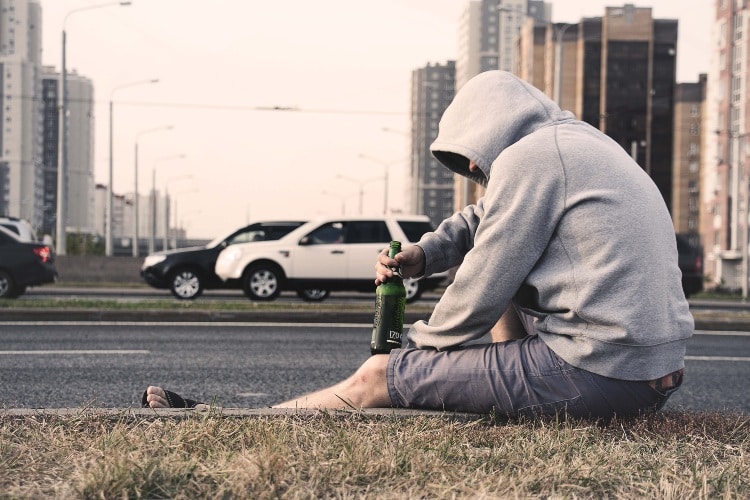Alcohol is, by far, the most used and abused addictive substance in the country. One out of every 12 adults suffers from alcohol abuse concerns. Between 2005 and 2009, 50 percent of Californian populations aged 12 and older were reported drinking alcohol in the past 30 years.
Drinking alcohol is not an issue, as it is an inexpensive, legal for those over age 21, readily available, and socially acceptable drink. Heavy drinking patterns may lead to the development of alcohol abuse.
Binge Drinking
Binge drinking is when a man drinks more than five drinks, or a woman drinks four in about two hours, and the blood alcohol concentration is raised above 0.08 g/dl.
About a quarter of the United States adult population binge drank in 2013, and it is one of the most common methods of excessive alcohol consumption.
As per a study by California State Epidemiological Outcome Workgroup (SEOW) Project, 2009—Alcohol remains one of the significant drug abuses among California students and adults, and it is widespread among school-age adolescents. Nearly twice as many students report the use of alcohol from 7th to 11th grade.
Past 30-Day Use of Tobacco, Alcohol, and Other Drugs among 7th,9th and 11th Graders, California, 2001- 2008
| 2001-2002 | 2003-2004 | 2005-2006 | 2007-2008 | |
| Percentages | ||||
| 7th Grade | ||||
| Alcohol Use | 10.4 | 10 | 12 | 14.8 |
| Binge Alcohol Use | 2.9 | 3.7 | 4.6 | 6.4 |
| 9th Grade | ||||
| Alcohol Use | 29.3 | 24.7 | 23.8 | 27.3 |
| Binge Alcohol Use | 13.4 | 11.5 | 11.5 | 15.8 |
| 11th Grade | ||||
| Alcohol Use | 40.7 | 37.1 | 35.8 | 41.9 |
| Binge Alcohol Use | 26.2 | 23.3 | 21.4 | 29 |
Source: California Student Survey, 2001-08, California Attorney General’s Office, Retrieved from http://www.safestate.org/documents/CSS_12th_Compendium_Tables.pdf, February 2009.
Selected Alcohol and Tobacco Consumption Indicators, California vs. United States, 2007
| Indicators | California | United States |
| Binge drinking among adults aged 18+ years | 16.90% | 15.80% |
| Binge drinking among women of childbearing age (18-44) | 13.40% | 14.60% |
| Heavy drinking among adult females 18+ years | 5.70% | 4% |
| Heavy drinking among adult males aged 18+ years | 6.50% | 6.10% |
| Cigarette smoking among adults aged 18+ years | 14.30% | 19.80% |
Source: Behavioral Risk Factor Surveillance Survey, Chronic Disease Indicators: State Profile, Centers for Disease Control and Prevention, 2007. Retrieved from http://apps.nccd.cdc.gov/cdi/ March 2009.
Prepared by: Epidemiology and Prevention for Injury Prevention Branch, CDPH, March 2009.
Traditionally, men are more inclined towards binge drink than women. Affluent individuals earning $75,000 or more per year are more likely to binge drink. With a high influx of tech jobs and an increase in wealthy professionals in San Francisco, it is no surprise to witness the rise in binge drinking rates in the state. The availability of alcohol and weak alcohol control policies may contribute to the increase of alcoholism among the Californian population. Californian involves binge drinking episodes almost 30 percent since 2002 and may continue to increase.

The Consequences
Alcohol abuse leads to health consequences such as substance-related risk behaviors and poisoning overdoses. This leads to intentional or unintentional injuries and long-term health impacts- chronic liver disease and lung cancer. And the most severe consequence is death.
Number and Rates of Alcohol and Drug-Related Deaths by Type, California, 2005-07
| 2005 | 2006 | 2007 | ||||
| # | Rate | # | Rate | # | Rate | |
| ALCOHOL | ||||||
| Mental and Behavioral Disorders | 1,042 | 993 | 660 | |||
| Physical Condition | 2,831 | 2,828 | 3,039 | |||
| Poisonings | 52 | 42 | 264 | |||
| Total | 3,928 | 10.6 | 3,863 | 10.3 | 966 | 10.5 |
| DRUG | ||||||
| Mental and Behavioral Disorders | 621 | 534 | 325 | |||
| Physical Condition | 0 | 2 | 0 | |||
| Poisonings | 1,084 | 1,252 | 1,333 | |||
| Pregnancy-related | 8 | 7 | 5 | |||
| Total | 1,713 | 4.6 | 1,795 | 4.8 | 1,663 | 4.4 |
| Total | 5,638 | 15.3 | 658 | 15.1 | 5,629 | 14.9 |
Notes: California residents only. Alcohol and drug-related deaths only include deaths with ICD-10 underlying cause of death codes 100% attributable to alcohol or drugs, respectively.
Source: Death Statistical Master and Birth Statistical Master files, 2005-7, Office of Vital Records, California Department of Public Health (CDPH); Race/Ethnic Population with Age and Sex Detail, 2000– 2050, California Department of Finance, July 2007
Prepared by: Epidemiology and Prevention for Injury Prevention Branch, CDPH, March 2009.
Number of Alcohol and Drug-related Deaths by Age, Gender, and Race/Ethnicity, California, 2007
| Alcohol | Drug | Total | |
| AGE | |||
| 0-20 Years | 14 | 59 | 73 |
| 21-29 Years | 75 | 156 | 231 |
| 30-39 Years | 246 | 267 | 513 |
| 40-49 Years | 980 | 533 | 1,513 |
| 50-59 Years | 1,384 | 499 | 1,833 |
| 60+ Years | 1,267 | 149 | 1,416 |
| GENDER | |||
| Male | 2,990 | 1,166 | 4,156 |
| Female | 976 | 497 | 1,473 |
| RACE/ETHNICITY | |||
| Hispanic/Latino | 1,288 | 368 | 1,656 |
| African-American | 236 | 207 | 443 |
| American Indian | 52 | 15 | 67 |
| Asian | 106 | 19 | 125 |
| Pacific Islanders | 5 | 2 | 7 |
| White | 2,257 | 1,033 | 3,290 |
| Multiple Race | 16 | 18 | 34 |
| Other/Unknown | 6 | 1 | 7 |
| TOTAL | 3,966 | 1,663 | 5,629 |

Key Findings
- Physical conditions such as hepatitis, tissue damage are the most common alcohol-related deaths rather than behavioral disorders.
- Every year, there is an increase in alcohol-related deaths than those of drug-related deaths. Of 5,629 deaths in 2007, 70% are due to alcohol.
- Over 10,000 deaths were due to alcohol impacting most deaths among adults.
- There’s a high chance of chronic causes such as alcoholic liver disease, alcohol-induced stroke, and alcohol dependence than from acute causes such as homicide, motor vehicle accidents, suicides. However, for those under 21 years old, they are much more likely to die from acute causes than chronic.
California Alcohol Abuse Treatment
- Between 2009-13m, around 186,000 Californians were treated for alcohol abuse every year.
- The state has launched Alcohol and drug prevention services targeted to younger audiences. Over 51% of those who received services were between 12 to 17 years.
- In 2012, in Los Angeles County, alcohol was the second most common reason for the prevention treatment admission behind marijuana.
- Drugs and alcohol are often combined as individuals may battle issues more than one substance at a time.

Alcohol Contribution to Crime
Alcohol impacts an individual’s impulse control functions, decision-making abilities, motor coordination, and reaction time. This results in a hazardous or criminal situation or injury.
In 2007, approx. 14,555 Californians suffered from a non-fatal motor vehicle crash in which alcohol was a significant reason. Around 1,263 alcohol-involved car crash fatalities were witnessed in 2009. Over 160,388 arrests were made in 2013 for driving under the influence (DUI). Almost a quarter of these arrests happened in Los Angeles County.
The primary reason for alcohol arrests in California is due to DUI, liquor law violation, or public intoxication. Alcohol also contributes to severe crimes such as homicide, sexual assault, spousal abuse, child neglect or abuse, or other violent acts.
Around 40 percent of Californian women are involved in physical intimate partner violence at some point in their lifetime.
Alcoholism and Mental Health
Alcohol is a psychoactive substance that induces pleasure and temporarily dull memory of trauma and emotional pain. Alcohol abuse is the first attempt to overcome emotional and mental illness symptoms, and it results in making them worse after a period.
It is estimated that alcohol abuse and mental illness co-occur around a third of the time. This increases the risk of suicidal thoughts.
Call Now
We're Here To Help!
Location
San Diego, CA 92109






